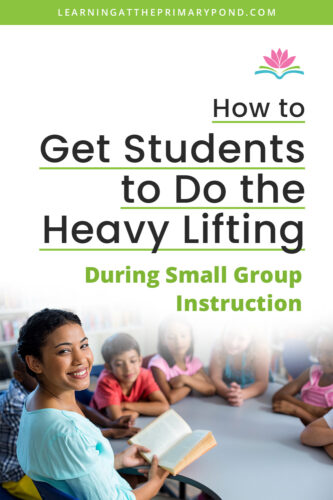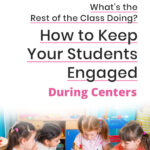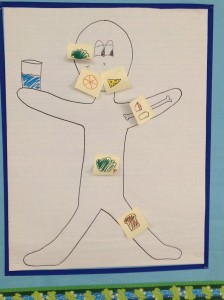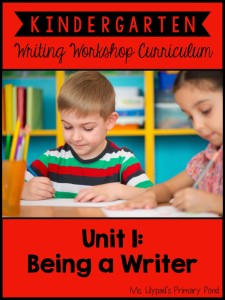Small group instruction time is critical – it provides a window (usually a small window!) to work on skills students need extra support with. You’re also trying to jam-pack a ton into a short amount of time. So, how can you maximize small group instruction time while also getting students to do the heavy lifting?
In this blog post, I’ll explain how I define “heavy lifting,” what the benefits are, and how to actually make students do the heavy lifting during small group instruction.

What is “heavy lifting” when it comes to literacy, and why is it important?
In the dictionary, “heavy lifting” is defined as the act of picking up and carrying heavy objects. This, of course, refers to the actual physical lifting of objects – lifting up a table, a desk, a pile of books. However, there are some things we can take away from this definition that translate to an academic setting. In a classroom, when students are doing the heavy lifting, they are picking up a lot of the responsibility. Students are carrying the workload.
Here’s what that looks/sounds like in a classroom:
- students being active listeners
- students responding to one another (not just answering your questions)
- students critically thinking
- students being willing to take chances and participate
- teachers not jumping in immediately to help or take over when a child struggles
- teachers acting as facilitators (which usually means less teacher talk, more student talk)
Let’s take a look at a couple of examples of what a small group comprehension discussion could look like.
Here’s Scenario #1:
Teacher: Adie, who was the main character of the story?
Adie: Stu.
Teacher: Yep! You’re right, Adie. Stu is the main character because the story is mostly about him. Okay, Cory– what was the setting of the story?
Cory: The city.
Teacher: The story does mention the city, but then Stu and his family travel to the farm for most of the story. So, the farm is actually the setting in this story. It’s where most of the story takes place.
If we’re talking analogies, this is more of a tennis drill. The teacher is on one side of the net and the students are in a line on the other side. The teacher “hits the ball”/asks the question, and one student “sends the ball back”/answers the question. That student steps to the end of the line, and the next student has a turn. It’s easy to fall into the trap of trying to get through a bunch of questions and therefore having the teacher just ask one quick question, followed by one student answering it.
So how could you turn this small group discussion into one where students are doing the heavy lifting? In this next example, the analogy is more like volleyball. The teacher “serves the ball”/asks the question, but then all students are on the other side of the net, “passing to one another”/engaging in student talk. Check out this example in Scenario #2:
Teacher: Who was the main character in the story?
Adie: I think the main character of the story was Stu.
Cory: I agree with Adie because most of the story was about Stu.
Terri: I also agree with Adie and Cory that Stu was the main character. The story also talked about Stu’s brother Lawson but not as much as Stu was talked about.
Teacher: What was the setting of the story?
Charlie: I think the setting of the story was the city.
Rachel: I respectfully disagree with Charlie. The story started in the city, but then Stu’s family went to the farm right away.
TJ: I also think the setting was at the farm. Most of the story was about Stu visiting the farm.
Charlie: Yeah, actually now that I’ve heard Rachel and TJ, I think I want to change my answer. Some of the story was in the city, but most of the story was at the farm. I’m going to change my answer to the farm.
Scenario #1 and Scenario #2 are quite different, right?
In Scenario #1:
- the teacher is the one who is affirming whether answers are correct/incorrect
- it only allows one student to really be engaged at a time (for instance, when the teacher calls on Adie specifically, the other students can instantly become disengaged since they know they’re “off the hook” for the time being)
- the teacher did over 96% of the talking
- only 2 students had a chance to talk
In Scenario #2:
- the students are affirming whether answers are correct/incorrect
- the students are listening and talking to one another
- students are engaged and listening to one another’s responses, pulling evidence from the text to strengthen answers
- the students are doing over 90% of the talking
- all 6 students had a chance to talk
Here are a couple of reasons why getting students to do the heavy lifting is important:
- increased communication skills
- stronger oral language (which can contribute to reading and writing skills)
- provides students time to process what has been taught
- fosters a sense of classroom community
- helps students make personal connections to instructional material (which helps with retention)
- allows students to learn from one another
- provides opportunities for students to use academic language
Now that we’ve covered what this can look like and why it’s important, let’s dive in a bit to show how this can be established.
How do you get students to do the heavy lifting?
Obviously, with Scenario #2, a lot of practice, work, and time went into achieving that! With each of these habits we’ll talk about why it’s important to use a gradual release model. In other words, you’ll model what it looks like, support the students in practicing the skills, and then establish it as a consistent expectation moving forward.
You’ll help by providing them sentence stems, and will of course need to prompt students when you first introduce these habits. (i.e. “Jen, can you repeat what Milo just said?”) Of course, sentence stems are just a temporary support – you eventually want it to become second nature for the students to use these skills.
I’m going to walk through a few of the core habits that I have seen work in Kindergarten, first grade, and second grade.
Skill #1: Repeat
The first skill I would have students learn about is repeating. This is simply listening to what another student says and repeating it back. The reason it’s important to teach this first is that students need to make sure they clearly heard what one student says before they begin to agree/disagree/expand on the original answer. This is especially helpful for partner talk.
Example:
Milo: The problem in the story was when Barry the Bear lost his favorite stuffed animal.
Jen: Milo said that the problem in the story was when Barry the Bear lost his favorite stuffed animal.
Skill #2: Agree
The next skill I’d teach students about is how to agree with someone. Once they’ve listened to what the other student has said, they would let them know if they have the same thoughts.
Milo: The problem in the story was when Barry the Bear lost his favorite stuffed animal.
Jen: Milo said that the problem in the story was when Barry the Bear lost his favorite stuffed animal. I agree with Milo.
Skill #3: Disagree
After students have learned how to agree, it’s important, of course, to teach them how to disagree. The biggest thing here is that they aren’t putting down someone else or saying their answer is “wrong.” Instead, they are defending their own thoughts with evidence.
Milo: The main character in the story was Zenny the Zebra.
Jen: Milo said that the main character in the story was Zenny the Zebra. I respectfully disagree with Milo. The main character in the story was Barry the Bear. Zenny the Zebra was one of the characters, but most of the text and pictures were about Barry the Bear.
Skill #4: Expand/Build
With this skill, you’re teaching students how to hear someone else’s response and add to it. Or, a student can go back to their original answer and build on to it, too.
Milo: The problem in the story was when Barry the Bear lost his favorite stuffed animal.
Jen: Milo said that the problem in the story was when Barry the Bear lost his favorite stuffed animal. I’d like to build on. This was a problem because it was the thing in the story that they were trying to solve the entire time. All the other characters had their favorite stuffed animals for show and tell, but Barry the Bear couldn’t find his.
Conclusion
I hope this information on getting students to do the heavy lifting was helpful! Obviously, there is A LOT to unpack. As the teacher, you’ll be doing a lot of prompting at first, and that’s okay! It’s also key to have wait time and provide students time to process.
I’d love to hear in the comments if you’ve tried rolling this out – and what’s gone well or what’s been difficult about it.
Happy teaching!












